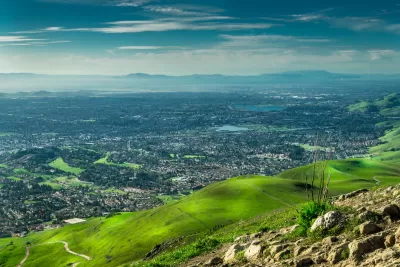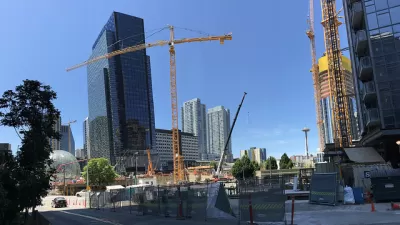Peter Calthorpe's case study of El Camino Real in the Silicon Valley shows the potential for affordable housing development in the land surrounding side right-of-ways.

In an analysis of parcels adjacent to the El Camino Real right-of-way (ROW), a vast commercial corridor spanning 43 miles in California's Silicon Valley, Peter Calthorpe found a tremendous opportunity for affordable housing development. According to Calthorpe's research, presented here by Robert Steutville, 20% of parcels along the ROW could be used for multifamily housing to support 250,000 additional units. Silicon Valley currently faces a shortage of 600,000 housing units.
"Better use of the 120-foot ROW would convert the current six-lane thoroughfare to one that includes bus rapid transit (BRT), generous sidewalks, and bicycle lanes—while retaining six lanes of through traffic," writes Steutville.
The case study showed a staggering capacity for residential and mixed-use buildings and bus rapid transit. "I think there is something better in the future than straight BRT, which is slow. It is the most affordable and equitable that we can get to right now. But there are autonomous buses coming from China, which will reduce operating expense," says Calthorpe.
Calthorpe sees affordable land to be among the key advantages of increasing housing in cities. Moreover, the adoption of tax increment financing (TIF) could "pay for transit, enhanced parks and schools, and to subsidize 20 percent inclusionary zoning," according to Calthorpe.
FULL STORY: The corridor model for more affordable housing

Planetizen Federal Action Tracker
A weekly monitor of how Trump’s orders and actions are impacting planners and planning in America.

San Francisco's School District Spent $105M To Build Affordable Housing for Teachers — And That's Just the Beginning
SFUSD joins a growing list of school districts using their land holdings to address housing affordability challenges faced by their own employees.

The Tiny, Adorable $7,000 Car Turning Japan Onto EVs
The single seat Mibot charges from a regular plug as quickly as an iPad, and is about half the price of an average EV.

With Protected Lanes, 460% More People Commute by Bike
For those needing more ammo, more data proving what we already knew is here.

In More Metros Than You’d Think, Suburbs are Now More Expensive Than the City
If you're moving to the burbs to save on square footage, data shows you should think again.

The States Losing Rural Delivery Rooms at an Alarming Pace
In some states, as few as 9% of rural hospitals still deliver babies. As a result, rising pre-term births, no adequate pre-term care and "harrowing" close calls are a growing reality.
Urban Design for Planners 1: Software Tools
This six-course series explores essential urban design concepts using open source software and equips planners with the tools they need to participate fully in the urban design process.
Planning for Universal Design
Learn the tools for implementing Universal Design in planning regulations.
Smith Gee Studio
City of Charlotte
City of Camden Redevelopment Agency
City of Astoria
Transportation Research & Education Center (TREC) at Portland State University
US High Speed Rail Association
City of Camden Redevelopment Agency
Municipality of Princeton (NJ)





























